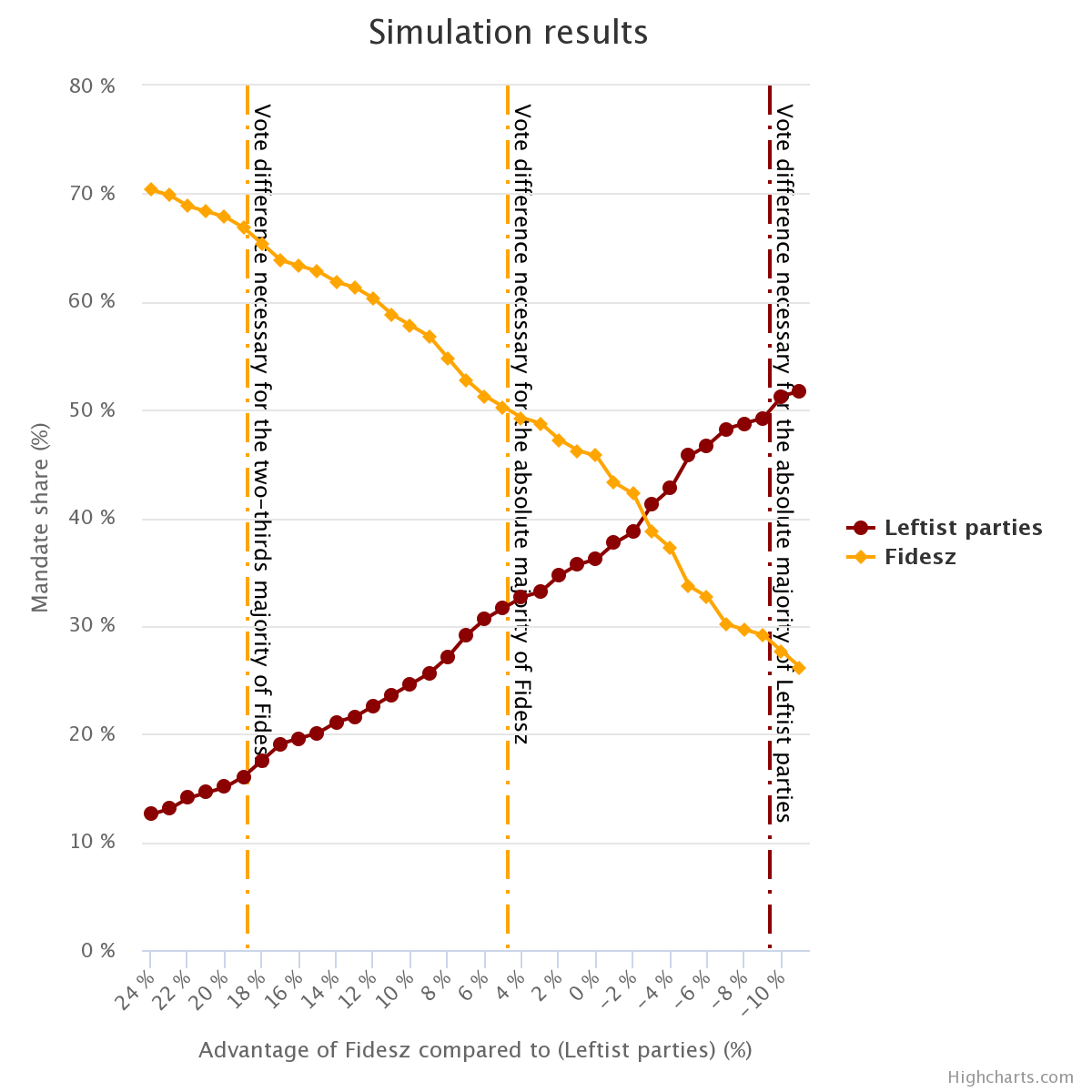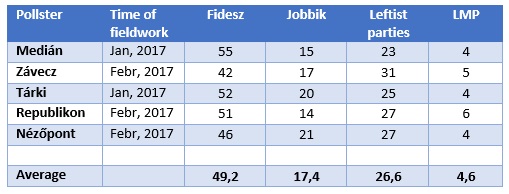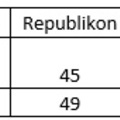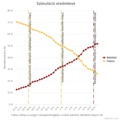Although at this moment it is very likely that the government party Fidesz will win the 2018 national election by a landslide, the race is still open: according to my calculations, it is also possible that no party will hold a majority after the election (thus ending in a ‘draw’). The outright victory of the leftist parties, or far-right Jobbik, however, is extremely unlikely.
In this blog, I advance a mandate calculator program: it assumes that the territorial distribution of each party’s support will remain at a similar level to the 2014 national election. It shows the vote share that is required to win a certain share/number of seats (equal number of seats, simple majority, and supermajority) for each party.
Based on the results of the last election forecasts in 2010 and 2014, and the results of the by-elections in 2015, it seems that the popularity of Fidesz is slightly over-estimated by the polls.
In order to prevent Fidesz gaining a majority, the opposition need to win 35-40 Single Member Districts (SMDs, e.g. individual constituencies) out of the 106 available. Although mathematically speaking, this does not seem impossible, the irrational and unpredictable behavior of the opposition begs the questions whether they are really motivated to achieve this.
At this moment in time (beginning of March, 2017), all polling companies shows that Fidesz has as many supporters as the opposition combined: the government is in an even better position than it was before its landslide win in 2014. Under these circumstances, what good is a mandate calculation, or political analysis, for that matter?
First of all, Fidesz’s position is – as I will demonstrate it – much more fragile than it seems. Secondly, at times, both the average voter and political actors can be unaware of the probabilities of various outcomes. Instead of the unsubstantiated claims that ’Fidesz will win easily no matter what’, it is worth examining what each side could achieve, and what chances they realistically possess.
Hungary has a mixed electoral system with two tiers: party list vote and votes for individual SMD-candidates. 106 seats will be obtained in SMDs (’first past the post’) and the remaining 93 seats will be allocated by proportional representation from national lists. Overall, due to the dominance of the SMDs, it is a disproportionate electoral system which benefits the victor.
I advanced and designed the mandate calculator (copyright, ©): a program, which predicts the seat share of the parties, based on their estimated vote share (language switcher is on the top right corner). As a first step, the user needs to estimate the popular vote share of each party: both domestic and out-of-country votes (that is for double citizens living in the neighboring countries). Then, the program calculates the seat distribution which would be – under certain assumptions – the result of the input given by the user. There is also an opportunity to create simulations: here – after the user provides his or her estimates – the program draws charts which show the relationship between votes and seats. The program will calculate what an increase in vote percentage (by 1 per cent) will look like in terms of number of seats: it also shows the vote difference (between the first and second party) required for a simple majority, supermajority (see chart). I created this software to help the public understand the Hungarian electoral system: so that everyone can see and comprehend the correlations between votes and seats. The program is completely transparent: each step is shown, explained and replicable. The detailed explanation can be found here at the methodological description.
In this study, first I introduce the basic assumptions of the mandate calculator. Then I delineate the various scenarios and their possible probabilities. I shall also elaborate on why I think Fidesz’ popularity is overestimated by the polls. In the final part, I will evaluate the room for maneuvers and constraints each player has to face.
Main assumptions of the model
- The mandate calculator assumes that, similarly to the 2014 national election, four party lists will enter the parliament and receive the overwhelming majority of the votes (95-97%): Fidesz, leftist parties (probably the Socialist Party and Gyurcsány’s party, DK), Jobbik and maybe the green LMP. It is also possible that instead of LMP, the newly founded Momentum movement, liberal-leftist Együtt (’Together’), green-left Párbeszéd (’Dialogue’), or frivolous Kétfarkú Kutyapárt (’Two-tailed Dog party’) will pass the five-percent threshold (or some combination/alliance of these). It is highly unlikely, however, that more than four (five with DK) lists will enter the parliament: these small parties’ constituencies overlap each other. All of them are concentrated on Budapest and relatively privileged citizens. So LMP can be substituted with each small party in the model.
- The territorial structure of each party’s popularity will remain unchanged in 2018. If the user doubles a party’s national popularity, then this party will receive twice as much vote share in every SMDs.
- In principle, the Hungarian electoral system permits minorities to be represented in the parliament. It is, however, very hard for them to receive a sufficient number of votes for that. The model assumes that, similarly to the 2014 national election, no minority representatives will receive this number.
- The user is required to give an estimate of the number of out-of-country votes (that is for double citizens living in the countries that neighbor Hungary). Out-of-country votes, however, have a very limited influence on the results: they can change only one seat.
Here is a detailed explanation of the Hungarian electoral system and here you can find the detailed methodological description of the model. Of course, these assumptions are not to be regarded as certain outcomes: this calculator provides an estimation, it is not a fortune-teller. We may estimate – based on the available information, such as polls – what will be the distribution of seats under a possible distribution of vote shares (given by the user). If it comes to the substitution of polling data into the model, it only makes sense without undecided voters. Figures should be based on all adults naming a party.
Main results of the calculations
- In order to achieve a two-third majority, Fidesz’ vote share needs to exceed leftist parties’ share and Jobbik’s share by at least 19 percentage points simultaneously (one is not enough). This is the most likely scenario based on the available current polling data. These numbers are based on the assumption that the fourth party (likely LMP) will receive 6 percent of the votes, the third party (the weaker party among Jobbik and the leftist alliance) will receive 25 percent, and three percent will be cast to parties outside the parliament (and no out-of-county votes are included in the model). The lower the vote share of the third party, the easier it is for the victor to obtain a supermajority.
- In order to achieve a simple but absolute majority, Fidesz’ vote share needs to exceed leftist parties’ share by a margin of at least 5 percentage points, and Jobbik’s share by at least 7 percentage points
- Equal number of seats (‘a draw’) between Fidesz and leftist parties can be expected if leftist parties were to receive 2-3 percentage points more votes than Fidesz. Equal number of seats between Fidesz and Jobbik can be expected if Jobbik will receive 1 percentage point less votes than Fidesz.
- In order to achieve a simple majority, leftist parties’ vote share needs to exceed Fidesz’ share by at least 10 percentage points (under the same conditions: Jobbik 25 percent, LMP 6 percent). In order to achieve a simple majority, Jobbik’s vote share needs to exceed Fidesz’ share by at least 5 percentage points (under the conditions that leftist parties got 25 percent, LMP 6 percent).
These results are replicable on the simulation menu. Based on the same conditions, the following chart visualizes the correlation between seat distribution and vote difference between Fidesz and leftist parties.

The main results are to be found on the next table (percentage points). For instance, Fidesz needs a 5 percentage point advantage over leftist parties and a 7 percentage point advantage over Jobbik for the absolute majority.

But why is it that leftist parties needs to recieve a higher vote share in order to achieve the same result as Jobbik and Fidesz? It is because the electoral system (introduced by the Fidesz government in 2011) clearly favours Fidesz against the leftist parties, but not against Jobbik. (Overview about the various aspects – including partisan bias and Constitutional Principles – of the electoral system can be found here). The key is the change of bounderies of SMDs. It is not simple gerrymandering: the historically leftist SMDs are in average bigger (approx. 80 thousand eligible voters) than the pro-government districts (approx. 75 thousand eligible voters). Thus, the voting power of leftist citizens is somewhat smaller: the difference is about 150 thousand votes). Jobbik has no such disadvantage – this is perhaps why it was Jobbik who has become the target of Fidesz’ high-profile negative campaign in the past several months.
The next table summarizes the current polls (only the face-to-face one, because this method is more reliable than the telepohne-interviews). Popularity of the leftist parties are to be found combined – although it is questionable whether all of them will endure each other or not . Figures are based on all adults naming a party.

Considering the current polling data, it quickly becames obvious that a leftist or Jobbik victory is unrealistic – even the ‘draw’ (e.g. equal number of seats) seems unlikely (it is worth putting this number into the mandate calculator). In my opinon, however, the popularity of Fidesz is significanlty (by 4-6 percentage points) over-estmimated by the polls – thus, a ‘draw’ is not impossible.
Why is the popularity of Fidesz over-estimated by the polls?
First of all, Hungarian pollsters are reliable: it is very rare that there is a major difference (e.g. bigger than the margin of error) between polls and actual election result. The only party whose popularity is systematically overestimated, is Fidesz. Being the dominant party, its supporters are more prone to declare their preferences - or give an interview - than other voters. The partisan and non-response bias is in accordance with the spiral of silence theory: opposition voters are slightly less likely to express their preferences because it’s socially less ‘desirable’ (this is the most frequent source of polling error world-wide).
In 2010, the polls had Fidesz’ popularity 6 percentage points higher than its actual result in the national elections, and in 2014 it was 5 percentage points higher than the eventual election results. Of course, pollsters are well aware that they may overestimate the dominants party’s popularity: sometimes, based on their own judgements, they alter the results of their last survey before the election. According to the Hungarian experience, this ‘expert judgement’ usually has led to more precise predictions. Fidesz should also be careful because the majority of undecided voters are dissatisfied with the government – they just haven’t found a viable alternative party (yet).
Furthermore, Fidesz had considerably worse results in the two by-elections in 2015 than the polls expected. In February 2015, Fidesz had 33.8 percent in the Veszprém district (leftist alliance won with 42,6 percent of the votes); in April, Fidesz reached 34.3 percent in Tapolca district (Jobbik won with 35.3 percent). In the 2014 national election, Fidesz had similar results in these SMDs as it had nationwide (43 percent in Tapolca, 47 percent in Veszprém). Thus, these are not even strongholds of the opposition parties: in both SMDs, Fidesz won by 20 percent in 2014. Hence, Fidesz could not have been able to achieve an absolute majority during these months. According to the mandate calculator, if in February 2015 Fidesz had had 33.8 percent in Veszprém, and in April 34.3 percent in Tapolca, then it must have been at 31 percent in February, and 34 percent in April nationwide. And yet, the polls showed 38 percentage in February and 37 percentage in April. Thus, in the Spring of 2015, Fidesz’ popularity in these SMDs was overestimated by 7 and 3 percent respectively.
Of course, it is debatable what conclusions can be drawn from the results of two SMDs (each is around one percent of the full population). A skeptic may argue that the opposition can mobilize and prepare for one SMD but are not strong enough to do the same for the whole country. This is, however, just as true for Fidesz as for the opposition. What cannot be questioned, nonetheless, is that the turning point was the migrant crisis in the Summer and Autumn of 2015: it made the position of Fidesz much stronger.
What are the chances now?
If the argument holds, we will assume that Fidesz’s popularity is overestimated by the same degree now, as it was in 2015. That means, it should be around 44 percent instead of 49 percent, whereas its rivals are a little underestimated as well. It is therefore realistic to assume that the actual popularity of Fidesz lies around the 44 percent mark, Jobbik 19 percent, leftist parties 28 percent and LMP 5 percent. This would still lead to a two-thirds majority for Fidesz, but it would also lead to a more precarious position for the government. If a small fraction of its support base would become uncertain (by about 6 percentage points), and leftist parties (or perhaps Jobbik) could capitalize on this and gain some new voter, this will mean that the loss of the absolute majority for Fidesz is within the margin of error. This much change in a campaign – when usually uncertain voters become active, and who’s majority are against the government in the first place – does not seem impossible. Moreover, the opposition parties had managed to appeal to many of these uncertain voters during the Spring of 2015 – in the upcoming election they would just need to ensure they get them back.
According to the mandate calculator, Fidesz needs to win around 67-70 SMDs in order to ensure its absolute majority. Hence, all the opposition has to do is prevent Fidesz from winning in 36-39 SMDs. Since there is a great degree of continuity of voting behavior between subsequent elections, it is already pretty obvious which SMDs are the “battleground states”. Both Jobbik and leftist parties should concentrate their resources on these districts.
Finally, it goes without saying that my model could not take into account everything. The individual candidates are not yet known for most of the SMDs. There is always some chance that something totally unexpected will occur, even in Hungarian politics: no one could have anticipated the breakthrough of Jobbik in 2009, or LMP in 2010. Nor was it expected that Momentum movement – which was a totally unknown organization two months ago – could collect 266 thousand signatures within 30 days for a referendum against Budapest’s 2024 Olympic bid, and thus force the government and Budapest to withdraw the city’s candidate status. Should the political landscape fundamentally change, I will alter my model accordingly. The abovementioned numbers reflect the current state of politics, as of beginning of March 2017.
***
To sum up, according to my calculations, the race is not yet decided in terms of mathematics. Thus, there is no guarantee that Fidesz will obtain an absolute majority and the next prime minister will be Viktor Orbán.
On the other hand, electoral mathematics depends on the rationality of each player and fair and undistorted circumstances of the race. The opposition has serious difficulties regarding campaign regulations and media-balance: the media is dominated by pro-government channels and outlets. Even more worrisome for opposition supporters is the fact that their own politicians seem to have a wrong perception about their chances. Gábor Vona, party chair of Jobbik, stated few weeks ago that he will immediately resign if Jobbik cannot beat Fidesz by at least one percent. This is highly unlikely at this moment. Instead of complacent optimism, pusillanimity characterizes the thinking of many leftist politician. They often accuse each other of not doing enough to beat Fidesz. Their seemingly low enthusiasm is explained by the misbelief that “Fidesz will win the next election no matter what”. Ironically, it is more likely this pessimistic attitude than the actual electoral mathematics which could ensure Fidesz’ next victory.


